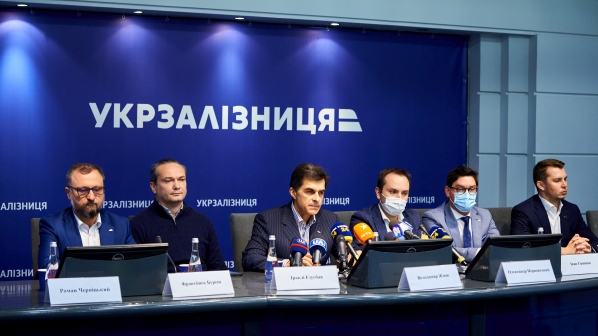Mr Volodymyr Zhmak, who was appointed chairman on August 26, said 2021 would be a breakthrough year for the railway.
The company is being split into four divisions, covering passenger, freight, production and infrastructure. UZ is in the process of allocating the required assets to each subsidiary, such as fleets to the freight and passenger divisions, and the maintenance and manufacturing facilities to the production division.
“In 2021, we plan to complete the subordination of UZ’s divisions so that each production vertical receives all the necessary assets so that they can calculate profits and losses and bring out their own balance sheets,” Zhmak says. “By the end of next year, each of these four verticals will have its own balance sheet, which will allow them to be reorganised in the holding company.”
Other services such as human resources, IT and in-house lawyers will be centralised at UZ’s head office.
Investment
Zhmak also announced that UZ plans to invest Hryvnia 26bn ($US 907.9m) in infrastructure, locomotives, freight wagons and passenger services in 2021, subject to approval from the Ukrainian government.
He says this new investment will significantly increase efficiency and bring the company to a sustainable level of profitability.
“2021 should be a breakthrough on the way to transforming UZ from a loss-making company into a profitable business,” Zhmak says. “This is not an illusion - UZ should end next year with a profit not on paper, in the form of exchange rate differences, but with real figures.”
Of this investment, Hryvnia 7bn will be allocated to renew UZ’s fleet of freight wagons.
“Today UZ has a low share of 19% in the freight market,” Zhmak says. “We will correct this situation quite aggressively and as soon as possible: from 19% we want to increase our market share to 35-40% by the end of next year.”
Overall, UZ is aiming to increase the level of freight it carries from 814,000 tonnes a day to one million tonnes a day in 2021 through a number of improvements to the company’s operating activities.
The service times have been extended in order to eliminate the shortage of locomotives, while dispatching and route shipment organisation has been improved. Maintenance spending has also been increased, with another Hryvnia 500m allocated to locomotive repairs and Hryvnia 350m to overhaul and modernise freight wagons.
“The market has received a signal that we can efficiently and quickly transport freight by rail, and the new management is ready for a constructive dialogue to improve cooperation and our tariff policy,” Zhmak says.
Hryvnia 4.1bn will be spent on locomotives next year, with the company planning to begin purchasing new electric locomotives in 2022.
“Our fleet of electric locomotives dates back to the 1970s and 80s, and we cannot achieve our ambitious plans for the growth of freight traffic with such a fleet,” Zhmak says. “Therefore, we will convince our shareholder, the Ukrainian government, that we need help in this regard.”
Hryvnia 9.4bn and Hryvnia 2bn will be spent on infrastructure and passenger services respectively. UZ also plans to purchase 100 coaches worth Hryvnia 2.7bn, and will spend Hryvnia 100bn to further electrify the network.
Zhmak says the investment is possible after the Ukrainian government has begun to pay more attention to UZ.
“In general, these figures will be the basis of our financial plan for 2021, which we will soon present to the company’s supervisory board, the Ministry of Infrastructure and the Cabinet of Ministers,” he says.

